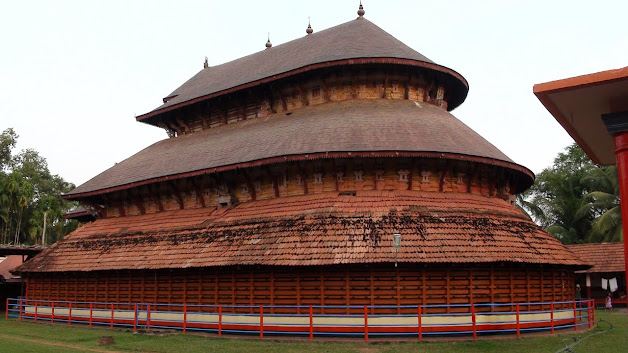Madhur Temple: Serenity of Mathanantheswara
Nestled along the serene banks of the River Madhuvahini in Kasaragod, the Madhur Temple is not just a place of worship, but a living museum of faith, architecture, and timeless stories. Believed to have been constructed by the Mypadi rulers of Kumbla in the 10th century, this temple has stood the test of time, witnessing centuries of devotion, invasion, and renewal. The structure that we see today owes much to the 15th-century rulers who renovated and expanded it, gifting Kerala one of its most striking examples of traditional temple design.
What makes the Madhur Temple unique is its fusion of Jain and Hindu architectural styles—a rare sight even in India’s culturally diverse landscape. The temple rises in three tiers, with the lower level roofed in terracotta tiles and the upper two tiers glimmering with copper tiles, reflecting sunlight like a divine crown. Inside, the temple reveals a world of craftsmanship beautifully carved wooden pillars, ornate beams, and stucco murals depicting episodes from Hindu mythology. The carvings in the Namaskara Mandapam especially tell stories from the Ramayana, making every step through the temple a journey through myth and art.
Though officially dedicated to Lord Shiva, the presiding deity in the hearts of devotees here is Lord Ganapathy, known affectionately as Bodda Ganesha. Legend tells of a young boy who once drew Ganapathy’s image on the temple’s southern wall. Over the days, the image began to grow miraculously in size, and the rulers, witnessing this divine manifestation, consecrated an idol of Ganapathy inside the Shiva sanctum. This sacred image is now counted among the six most revered Ganapathy idols in the ancient world, alongside those at Sharavu (Mangalore), Anegudde, Hattiangadi, Idagunji, and Gokarna.
Another story that adds to the temple’s mystique dates back to the time of Tipu Sultan’s invasion. Known for demolishing temples during his southern campaigns, Tipu reached Madhur but was overcome by thirst. He drank water from the temple’s well, and, moved by an inexplicable sense of calm, decided to spare the shrine. To appease his soldiers, he merely struck a small mark on the temple wall with his sword, a scar that still remains silently narrating this extraordinary tale. The same well from which he drank is said to hold curative properties, as its water, deep within the earth, has never been touched by sunlight.
For devotees, a visit to Madhur Temple is not complete without offering appams (sweet rice cakes) to Lord Ganapathy, who is said to have a fondness for this delicacy. The most significant offerings here are the Sahasrappam, where a thousand appams are made and offered, and the Moodappam, where the idol is completely covered with appams, a sight that fills the temple with the aroma of devotion and sweetness. The rituals here are deeply rooted in the Tulu Brahmin traditions, and the temple continues to preserve the spiritual heritage of the Shivali Brahmin community who serve as priests.
Stepping into Madhur Temple is like stepping into a sacred past where myths breathe through stone walls and the river whispers ancient prayers. Its divine aura, stunning architecture, and enchanting legends make it a must-visit for any traveler seeking to experience the soul of Kerala’s spiritual and cultural essence.



.jpeg)
Comments
Post a Comment